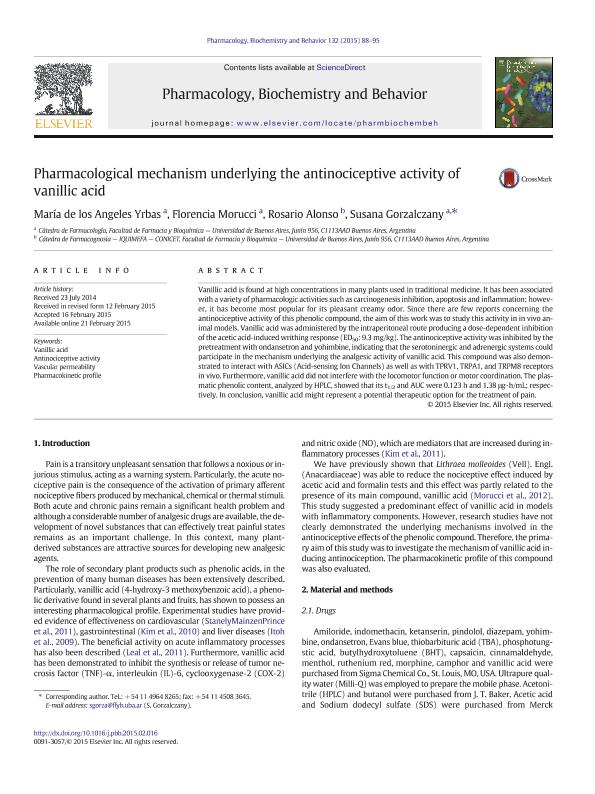Artículo
Pharmacological mechanism underlying the antinociceptive activity of vanillic acid
Yrbas, Maria de Los Angeles; Morucci, Florencia; Alonso, Maria del Rosario ; Gorzalczany, Susana Beatriz
; Gorzalczany, Susana Beatriz
 ; Gorzalczany, Susana Beatriz
; Gorzalczany, Susana Beatriz
Fecha de publicación:
05/2015
Editorial:
Elsevier Inc
Revista:
Pharmacology Biochemistry and Behavior
ISSN:
0091-3057
Idioma:
Inglés
Tipo de recurso:
Artículo publicado
Clasificación temática:
Resumen
Vanillic acid is found at high concentrations in many plants used in traditional medicine. It has been associated with a variety of pharmacologic activities such as carcinogenesis inhibition, apoptosis and inflammation; however, it has become most popular for its pleasant creamy odor. Since there are few reports concerning the antinociceptive activity of this phenolic compound, the aim of this work was to study this activity in in vivo animal models. Vanillic acid was administered by the intraperitoneal route producing a dose-dependent inhibition of the acetic acid-induced writhing response (ED50: 9.3 mg/kg). The antinociceptive activity was inhibited by the pretreatment with ondansetron and yohimbine, indicating that the serotoninergic and adrenergic systems could participate in the mechanism underlying the analgesic activity of vanillic acid. This compound was also demonstrated to interact with ASICs (Acid-sensing Ion Channels) as well as with TPRV1, TRPA1, and TRPM8 receptors in vivo. Furthermore, vanillic acid did not interfere with the locomotor function or motor coordination. The plasmatic phenolic content, analyzed by HPLC, showed that its t1/2 and AUC were 0.123 h and 1.38 μg·h/mL; respectively. In conclusion, vanillic acid might represent a potential therapeutic option for the treatment of pain.
Archivos asociados
Licencia
Identificadores
Colecciones
Articulos(IQUIMEFA)
Articulos de INST.QUIMICA Y METABOLISMO DEL FARMACO (I)
Articulos de INST.QUIMICA Y METABOLISMO DEL FARMACO (I)
Citación
Yrbas, Maria de Los Angeles; Morucci, Florencia; Alonso, Maria del Rosario; Gorzalczany, Susana Beatriz; Pharmacological mechanism underlying the antinociceptive activity of vanillic acid; Elsevier Inc; Pharmacology Biochemistry and Behavior; 132; 5-2015; 88-95
Compartir
Altmétricas



